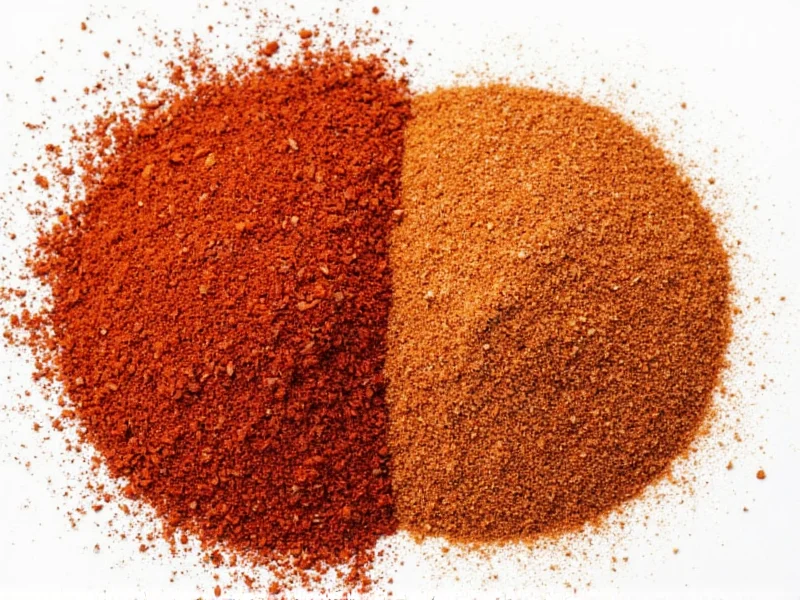When you're reaching for that spicy kick in your pasta sauce or pizza, you've probably wondered: crushed red pepper vs red pepper flakes—are these actually different ingredients? The straightforward answer is no. Despite the slightly different phrasing, these terms refer to identical culinary products found in nearly every supermarket spice aisle.
Understanding the Terminology
The confusion between crushed red pepper and red pepper flakes stems primarily from regional naming preferences and marketing variations rather than any substantive difference in the product itself. Food manufacturers and recipe developers use both terms to describe the same dried, crushed chili peppers—typically cayenne peppers—that deliver that familiar spicy heat to dishes.
Historically, "red pepper flakes" became the more common term in home cooking circles, while "crushed red pepper" appears frequently on commercial packaging. This linguistic variation has created unnecessary confusion among home cooks who worry they might be using the wrong ingredient.
Physical Characteristics Comparison
When examining both products side by side, you'll notice identical characteristics regardless of which name appears on the label:
| Characteristic | Crushed Red Pepper | Red Pepper Flakes |
|---|---|---|
| Base Ingredient | Dried cayenne peppers | Dried cayenne peppers |
| Texture | Irregular flakes of varying sizes | Irregular flakes of varying sizes |
| Color | Bright red to dark crimson | Bright red to dark crimson |
| Heat Level | 30,000-50,000 Scoville units | 30,000-50,000 Scoville units |
| Flavor Profile | Earthy, slightly fruity, spicy | Earthy, slightly fruity, spicy |
Why the Different Names Exist
The variation in terminology represents marketing preferences rather than product differences. Some brands opt for "crushed red pepper" because it sounds more descriptive of the manufacturing process, while others choose "red pepper flakes" as it emphasizes the physical form of the final product.
Regional factors also play a role. In certain parts of the United States, one term may dominate local usage, creating the impression of a meaningful distinction where none exists. Food manufacturers sometimes switch between terms for different product lines without changing the actual contents.
Practical Usage in Cooking
Whether your recipe calls for crushed red pepper or red pepper flakes, you can use them interchangeably with complete confidence. Professional chefs and food scientists confirm there's no culinary reason to distinguish between these terms when following recipes.
Both products work equally well for:
- Adding heat to pasta sauces and pizza
- Creating spice rubs for meats
- Enhancing salad dressings and marinades
- Providing texture and heat to roasted vegetables
- Adding complexity to soups and stews
Substitution Guidance
When substituting between these identical products, no measurement adjustments are necessary. One teaspoon of crushed red pepper equals one teaspoon of red pepper flakes in every culinary application. This 1:1 substitution ratio holds true regardless of the recipe or cooking method.
For those concerned about crushed red pepper vs red pepper flakes substitution in sensitive recipes, rest assured that any perceived flavor differences would stem from batch variations in the peppers themselves rather than the labeling terminology.
Storage and Shelf Life Considerations
Both products share identical storage requirements and shelf life characteristics. To maintain optimal flavor and heat:
- Store in airtight containers away from light and heat
- Keep in a cool, dark pantry rather than near the stove
- Expect peak flavor for 6-12 months after opening
- Replace when the vibrant red color fades significantly
Properly stored, both crushed red pepper and red pepper flakes gradually lose potency but remain safe to consume indefinitely. The primary indicator of diminished quality is reduced heat intensity and faded color.
Common Misconceptions Addressed
Several persistent myths surround these products:
- Myth: Crushed red pepper contains additional ingredients
Fact: Pure crushed red pepper contains only dried, crushed chili peppers - Myth: Red pepper flakes are milder than crushed red pepper
Fact: Heat levels depend on the specific pepper batch, not the labeling - Myth: Crushed red pepper is coarser than red pepper flakes
Fact: Texture varies by brand, not by terminology
Practical Recommendations for Home Cooks
When shopping for this versatile spice, focus on these practical considerations rather than the labeling terminology:
- Check the ingredient list for pure chili peppers without additives
- Look for vibrant red color indicating freshness
- Consider buying smaller quantities to ensure freshness
- Store properly to maintain heat and flavor profile
- Don't worry about difference between crushed red pepper and red pepper flakes when following recipes
Understanding that crushed red pepper and red pepper flakes are the same eliminates unnecessary stress in the kitchen and simplifies your spice cabinet organization. This knowledge empowers you to focus on the actual quality of the product rather than being distracted by meaningless labeling variations.











 浙公网安备
33010002000092号
浙公网安备
33010002000092号 浙B2-20120091-4
浙B2-20120091-4